Your deck is exposed to some of the harshest conditions. From extreme cold and buckets of snow in the winter to extreme heat in the summer and plenty of rain in the spring and fall, your deck has to deal with it all. All that weathering can take a toll on the health and structure of any deck and leave it looking a little worse for wear.
Eventually, you’ll need to repair or replace your deck. Keep reading to learn the kinds of damage you should watch out for as well as when you can repair your deck — and when it might be time to upgrade to a more durable deck solution.
When to Repair Your Deck
Since every deck tends to take a beating, how can you tell when your deck is just getting older, or if it’s time for some serious repairs? Here are a few key signs that indicate it’s time to repair your deck:
- Loose boards
- Rotten boards or beams
- Shaky railings
- Cracked boards
- Compromised joists and beams
- Rusted nails and hardware
Loose Boards
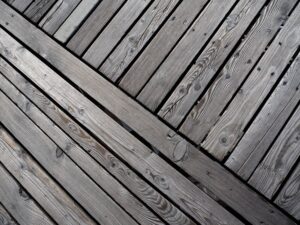
Any sign of your deck wiggling isn’t a good thing. Whether you’ve noticed a few floorboards are loose or the entire structure seems a little unstable, you’ll want to investigate the problem before you start to repair your deck. A few loose boards are easily repaired, but if your entire deck seems shaky, you’ll probably have to start thinking about a deck replacement.
Rotten Boards or Beams
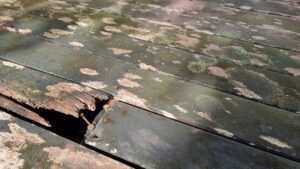
Rotted wood is a surefire sign that it’s time for a bit of deck maintenance. You can check for rot easily with a screwdriver. Simply walk around the deck, tapping on potential trouble spots where maybe you’ve noticed a lot of water pooling. When the wood feels soft under the screwdriver, and your taps start to sound like mushy “thuds,” you’ve hit wood rot.
It’s possible that only a small section of your deck has rotted, in which case you can usually replace just the affected boards — as long as the rest of your deck is in good shape. If you notice structural and support beams rotting, you are probably looking at a bigger deck repair.
Shaky Railings
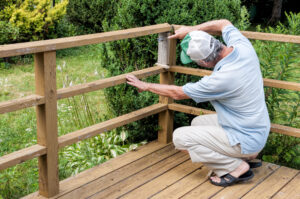
If your railings are shaky, you’ll need to repair your deck. While the railing isn’t a major structural component of your deck, it is a big safety feature, especially if you have kids or if your deck is on an elevation.
If you notice your railing wobbling, first check the rest of your deck to make sure there aren’t problems with rot or rust elsewhere. If not, you may be able to simply tighten a few screws and add a few fasteners. If the damage to your deck railing is more extensive, you might have to put in a brand-new railing.
Cracked Boards
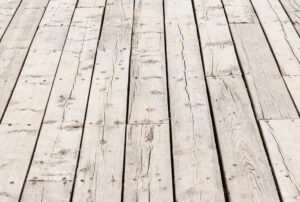
It’s time to repair your deck when you notice the boards of your deck cracking and splitting. Not only are these splinters hard on the feet, but they’re a sign that your decking just isn’t holding up anymore.
This is part of the natural aging process with older wood decks. As temperatures and humidity levels change, the wood swells and contracts. As the wood ages and dries out, this tends to lead to cracks. You’ll also notice cracks if you haven’t stained or sealed your deck in a while.
A few cracked deck boards can certainly be replaced, but if you’re noticing cracking happening all over the surface of your deck, it’s probably time to think about repairs or even replacement.
Compromised Joists and Beams
Your deck’s joists and beams are its most important structural components. These are the boards that support your deck and make up the platform below the part of the deck that you walk on. They should look strong and sturdy, like this:
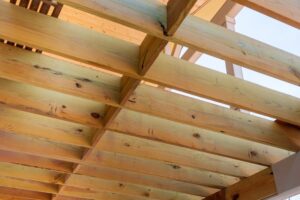
If you notice any of these rotting, or if your deck seems to have shifted slightly off these supports, you need to replace or repair your deck. When joists and beams are compromised, your deck is no longer safe. Since these posts make up the foundation and structure for your deck, you need these in shape before you can host any summer deck parties.
To fix joists and beams, you’ll need to remove the boards that make up the platform of your deck, which takes a long time, and if you’re hiring someone, a lot of manpower. Many homeowners choose to simply replace their deck if major structural components like these have been compromised because they can be so expensive to fix.
Rusted Nails and Hardware
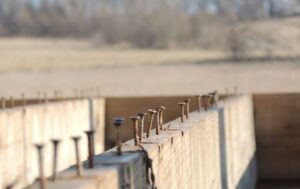
Rusted nails and bolts are another sign that your deck is getting up there in years. The more rusted those nails and bolts become, the more dangerous your deck is. Since nails and bolts are what hold everything together, you really can’t have them weakened by rust.
If you notice any rust happening on your deck, it’s best to just replace the rusty hardware. The sooner you get them switched out, the fewer problems you’re likely to have.
When to Upgrade to Composite Decking
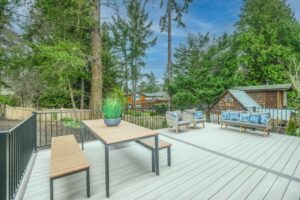
If you keep noticing problems with your wood deck and feel like you’re always working to repair, stain, or re-seal your deck, it may be time to replace your wood deck with a composite option from Trex®. While composite decking can be more costly than wood upfront, composite decking is the lowest maintenance deck material. No more warping or cracking, loose or rotten boards, and no more sanding and refinishing!
There are a few ways to replace your wood deck with composite decking:
- Replace the entire wood deck with a composite deck
- Replace just the deck surface (platform) with composite deck materials
Option 1: Replace Your Whole Wood Deck With Composite Decking
Let’s say your existing wood deck has just seen too many years. The joists and supports aren’t what they used to be, and the deck itself just doesn’t seem structurally sound. This is your best opportunity to get rid of that old, shaky wood deck and replace the entire thing with composite decking.
At this point, you’re not missing out on any leftover life from the old deck, and you’d probably have to replace the old deck entirely anyway. If you’ve been thinking about making the switch to composite decking, now is the best time to do it.
Option 2: Replace Your Deck Platform With Composite Decking
There are some situations where you may be able to replace just the platform of your deck with composite decking.
If the structure of your deck is in great shape, you can simply remove the top layer of wood boards and replace that with composite decking materials. This applies if the top of your deck seems to be splintering and cracking, but the structure underneath is very solid. The joists and beams are all in good shape, and you’re not noticing any wobbling or shaking.
This isn’t the best solution for every deck, so always consult with a composite decking installation professional before you start any composite decking project. But it can be a great way to reuse a strong deck support system (and possibly save a little money) while getting a brand-new, beautiful composite deck that’s sure to last for decades.
Get Replacement Decking Materials at Zeeland Lumber & Supply
If your deck has seen better days, don’t worry. Zeeland Lumber & Supply offers the very best materials in both pretreated lumber and composite decking, including Trex, to fix it right up! Stop into one of our locations or request a decking quote for more information about getting your deck back in shape as soon as possible.


